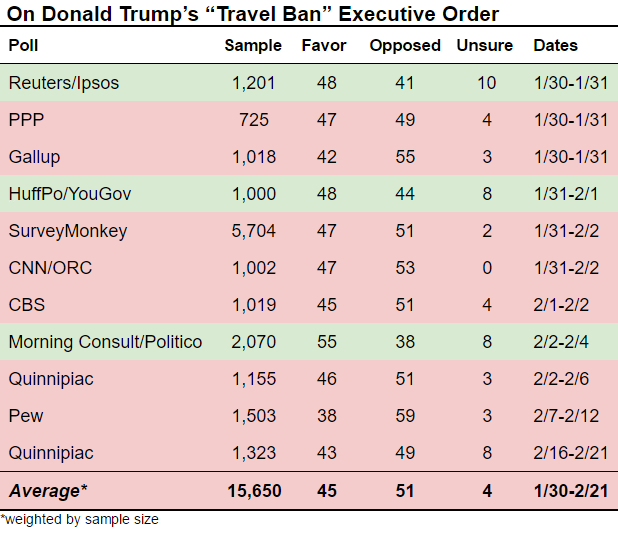President Donald Trump falsely tweeted that all negative polls about his immigration executive orders were fake news. Now that he is expected to issue similar orders this week to renew the travel ban from seven Muslim-majority countries, it is fitting to review just what those polls said. He claims Americans approve of his executive order instituting a targeted ban, but that story would only hold weight if you throw out all counter-evidence.
Of the eleven major polls conducted since President Trump had signed the controversial executive order, he insists eight of them must be fake because they reveal that the ban is not popular. Trump interprets immigration policy as a set of policies imposed on the American people by globalist elites, but public opinion polling shows that he is the one imposing unpopular policies.
Polls on his executive order suspending immigration from seven countries show that a majority of Americans oppose it. In fact, the executive orders have net disapproval of more than five percentage points, with only 45% of people in favor and 51% opposed.
Only one poll shows a majority of Americans approve of the order. In fact, most of them conclude that a majority are against it.
The three polls that showed net approval (Reuters/Ipsos, HuffPo/YouGov, and Morning Consult/Politico) were all conducted online, where it is notoriously difficult to collect a representative sample. Even if it is true, as some have suggested, that people are more likely to give their honest opinions online, online polls and automated phone polls do not even show net approval for the executive order consistently.
Taking all the polls together shows that even with Trump-slanted online polls, most Americans do not approve of the ban.
Opposition on the Rise
Trump appears to cling to his scant pro-ban polls, and find more comfort in polls conducted before he actually signed the executive order. Last month, two polls were conducted that tested support for the policy, and found more support for the ban than there is now.
First, Quinnipiac found a net approval of 6 for a ban before Trump took office. To compare, its two polls after he signed the order show a net approval of -6. That is a 12 percentage point swing against the ban. Meanwhile, the first two Quinnipiac polls also showed an increase in Trump’s net approvals while public support swung against the ban. So it is not just partisanship driving the results.
Second, Rasmussen found support of the ban at a whopping 24 percentage points in a poll conducted days before the order was signed. But the distinct way it phrased its questions was bound to bump up the number of people who said they approved the policy. Rasmussen has a history of conservative bias, therefore leading to it finding more support for Republicans and Republican causes than other polls.
Whatever the details of the specific polls, the takeaway from examining all of them together is that voters are more opposed to the ban now than they were last month or throughout the election, when polls generally showed more support for a Muslim ban. Some of the opposition to the ban is principled, but some must also be attributed to the association with the polarizing Donald Trump.
And, some of the decreased support for a ban can be directly attributed to the chaos and poor planning of the rollout, the unnecessary cruelty the policy unleashed, and that the public has now heard how the pan will make them less safe from a bipartisan group of national security experts and officials.
It’s possible that renewing the ban with a deliberate rollout will ease some of the opposition. But that still doesn’t make it a good idea. Regardless, the best polling evidence we have says that the public already realizes the travel ban is bad news.
